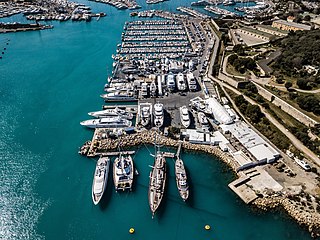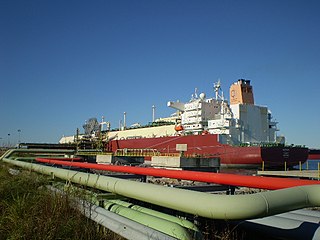
Kawasaki Heavy Industries Ltd. (KHI) is a Japanese public multinational corporation primarily known as a manufacturer of motorcycles, engines, heavy equipment, aerospace and defense equipment, rolling stock and ships. It is also active in the production of industrial robots, gas turbines, boilers and other industrial products. The company is named after its founder Shōzō Kawasaki, and has dual headquarters in Chūō, Kobe and Minato, Tokyo.

A shipyard is a place where ships are built and repaired. These can be yachts, military vessels, cruise liners or other cargo or passenger ships. Dockyards are sometimes more associated with maintenance and basing activities than shipyards, which are sometimes associated more with initial construction. The terms are routinely used interchangeably, in part because the evolution of dockyards and shipyards has often caused them to change or merge roles.

Hyundai Glovis Co., Ltd. is a logistics company headquartered in Seoul, South Korea and part of the Hyundai Kia Automotive Group. Its predecessor company, Hankook Logitech Co. Ltd was formed in February 2001. Hyundai Glovis supplies ocean transportation logistics advice, cargo space, loading/unloading, and packaging services. It changed its name to Hyundai Glovis in June 2003.

Hyundai Heavy Industries Co., Ltd. is the world's largest shipbuilding company. Its headquarters are in Ulsan, South Korea. HHI was founded in 1972 by Chung Ju-yung as a division of the Hyundai Group, and in 1974, completed building its first ships. In 2002, the company was spun-off from its parent company. HHI has four core business divisions: Shipbuilding, Offshore & Engineering, Industrial Plant & Engineering, and Engine & Machinery. HHI also has five non-core related subsidiaries: Hyundai Electric & Energy Systems, Hyundai Construction Equipment, Hyundai Robotics, Hyundai Heavy Industries Green Energy, and Hyundai Global Service.

A merchant ship, merchant vessel, trading vessel, or merchantman is a watercraft that transports cargo or carries passengers for hire. This is in contrast to pleasure craft, which are used for personal recreation, and naval ships, which are used for military purposes.

A floating production storage and offloading (FPSO) unit is a floating vessel used by the offshore oil and gas industry for the production and processing of hydrocarbons, and for the storage of oil. An FPSO vessel is designed to receive hydrocarbons produced by itself or from nearby platforms or subsea template, process them, and store oil until it can be offloaded onto a tanker or, less frequently, transported through a pipeline. FPSOs are preferred in frontier offshore regions as they are easy to install, and do not require a local pipeline infrastructure to export oil. FPSOs can be a conversion of an oil tanker or can be a vessel built specially for the application. A vessel used only to store oil is referred to as a floating storage and offloading (FSO) vessel.

A tanker is a ship designed to transport or store liquids or gases in bulk. Major types of tankship include the oil tanker, the chemical tanker, and gas carrier. Tankers also carry commodities such as vegetable oils, molasses and wine. In the United States Navy and Military Sealift Command, a tanker used to refuel other ships is called an oiler but many other navies use the terms tanker and replenishment tanker.

A tank truck, gas truck, fuel truck, or tanker truck or tanker, is a motor vehicle designed to carry liquids or gases on roads. The largest such vehicles are similar to railroad tank cars which are also designed to carry liquid loads. Many variants exist due to the wide variety of liquids that can be transported. Tank trucks tend to be large; they may be insulated or non-insulated; pressurized or non-pressurized; and designed for single or multiple loads. Some are semi-trailer trucks. They are difficult to drive and highly susceptible to rollover due to their high center of gravity, and potentially the free surface effect of liquids sloshing in a partially filled tank.

BW Group is a leading global maritime company involved in shipping, floating infrastructure, deep-water oil & gas production, and new sustainable technologies. The company controls a fleet of over 420 vessels transporting oil, gas, and dry commodities, managed by an international team of over 9000 staff worldwide. The group was founded by Sir Yue-Kong Pao in Hong Kong in 1955 as World-Wide Shipping. In 2003, the company acquired Bergesen d.y. ASA, Norway's largest shipping company, which was founded in 1935 by Sigval Bergesen the Younger. In 2005, the business was re-branded as BW. With its LNG and LPG fleets combined, BW Group owns and operates the world's largest gas shipping fleet of 190 gas vessels, including five FSRUs. Hafnia, a member of the BW Group, operates the world's largest fleet of oil product tankers, and BW Offshore comprises the second largest number of floating oil and gas production units (FPSOs). In the renewables space, the group has investments in solar, wind, batteries, biofuels, and water treatment.

Hyundai Samho Heavy Industries Co., Ltd. is the world's 4th largest shipbuilder and produces approximately 40 vessels per year. Its yard is located in Samho-eup, Yeongam, South Korea.
Q-Flex is a type of ship, specifically a membrane type liquefied natural gas carrier.

Q-Max is a type of ship, specifically a membrane type liquefied natural gas carrier. In the name Q-Max, "Q" stands for Qatar and "Max" for the maximum size of ship able to dock at the LNG terminals in Qatar. Ships of this type are the largest LNG carriers in the world.
Compressed natural gas (CNG) carrier ships are those designed for transportation of natural gas under high pressure. CNG carrier technology relies on high pressure, typically over 250 bar (2900 psi), to increase the density of the gas, but it is still 2.4 times less than that of LNG (426 kg/m3). CNG carriers may find their place abreast with the well established technology of liquefied natural gas by LNG carriers as it is economical for medium distance marine transport. Most of the energy consumed for the gas pressurisation can be recovered as electricity using turboexpander while delivering CNG to the inland piping network at unloading jetty/harbour. CNG carriers are also alternate solutions to the undersea pipelines as they have less complicated fast loading and unloading features.
Hyundai Mipo Dockyard is one of the largest shipbuilding companies with world share rank 1 (50%) in PC. Since the 1980s, more than 10,000 ships were repaired and converted until 2005 and 400 newly ordered ships were delivered until 2009. It delivers about 70 new ships in a year by Hyundai Mipo Dockyard. The delivered amount is over 1 million CGT in a year (2007), making it 4th in the world. Its product mix is shipbuilding (96.4%) and conversion and repair (3.6%). Hyundai Mipo Dockyard is a member of Hyundai Heavy Industries Group and listed on KOSPI in 1983.
Sture Terminal is an oil terminal at Stura in Øygarden municipality, 50 km (31 mi) northwest of Bergen, Norway. It receives oil and condensate from Oseberg, Veslefrikk, Brage, Oseberg Sør, Oseberg Øst, Tune and Huldra fields through 115 km (71 mi) Oseberg Transport System (OTS) and oil from Grane oil field through 212 km (132 mi) Grane oil pipeline.
BP Shipping is the maritime arm of British headquartered global oil company, BP. The unit covers the marine transport, logistics and insurance requirements of all BP's global activities.
Hanjin Heavy Industries and Construction Philippines, known as HHIC Phil, was established in February 2006 by Hanjin Heavy Industries and Construction of South Korea. In the same month, the first ship building contract was signed for 4 container ships. In May 2006, the construction of a shipyard began on Redondo Peninsula - on the northern edge of Subic Bay.
LPG/C Ayame is a Very Large Gas Carrier (VLGC), with a capacity of 83,000 m3 (2,900,000 cu ft), delivered in 2010 from MHI Ltd. of Nagasaki, and under the management of Wilhelmsen Lines Malaysia.
A gas carrier is a ship designed to transport LPG, LNG, CNG, or liquefied chemical gases in bulk.

Costa Azul LNG is sea port and natural gas processing center, located 15 miles north of Ensenada, Baja California, Mexico. Opened in 2008, the terminal can process, regasification, up to one billion cubic feet of natural gas per day. This is the first liquefied natural gas (LNG) terminal on the North America west coast. LNG carrier ships capable of holding up to 220,000m3 of LNG can dock in the deep water port off the coast to unload LNG. The natural gas from the terminal is used to produce electricity and is fed by pipe lines to factories. The longest pipeline runs north, to the United States. Sempra Energy is a partner in the port with PEMEX. The LNG ship Al Safliya was the first ship to port and unload at Costa Azul. The Al Safliya is a 210,000 cubic meter LNG ship, its LNG was from Qatar. The other Mexican LNG Terminal in the Pacific Ocean is at Manzanillo, Colima, the Manzanillo LNG Terminal.












